MERCEDES-BENZ ML320 2010 W164 Owner's Guide
Manufacturer: MERCEDES-BENZ, Model Year: 2010, Model line: ML320, Model: MERCEDES-BENZ ML320 2010 W164Pages: 368, PDF Size: 9.09 MB
Page 31 of 368
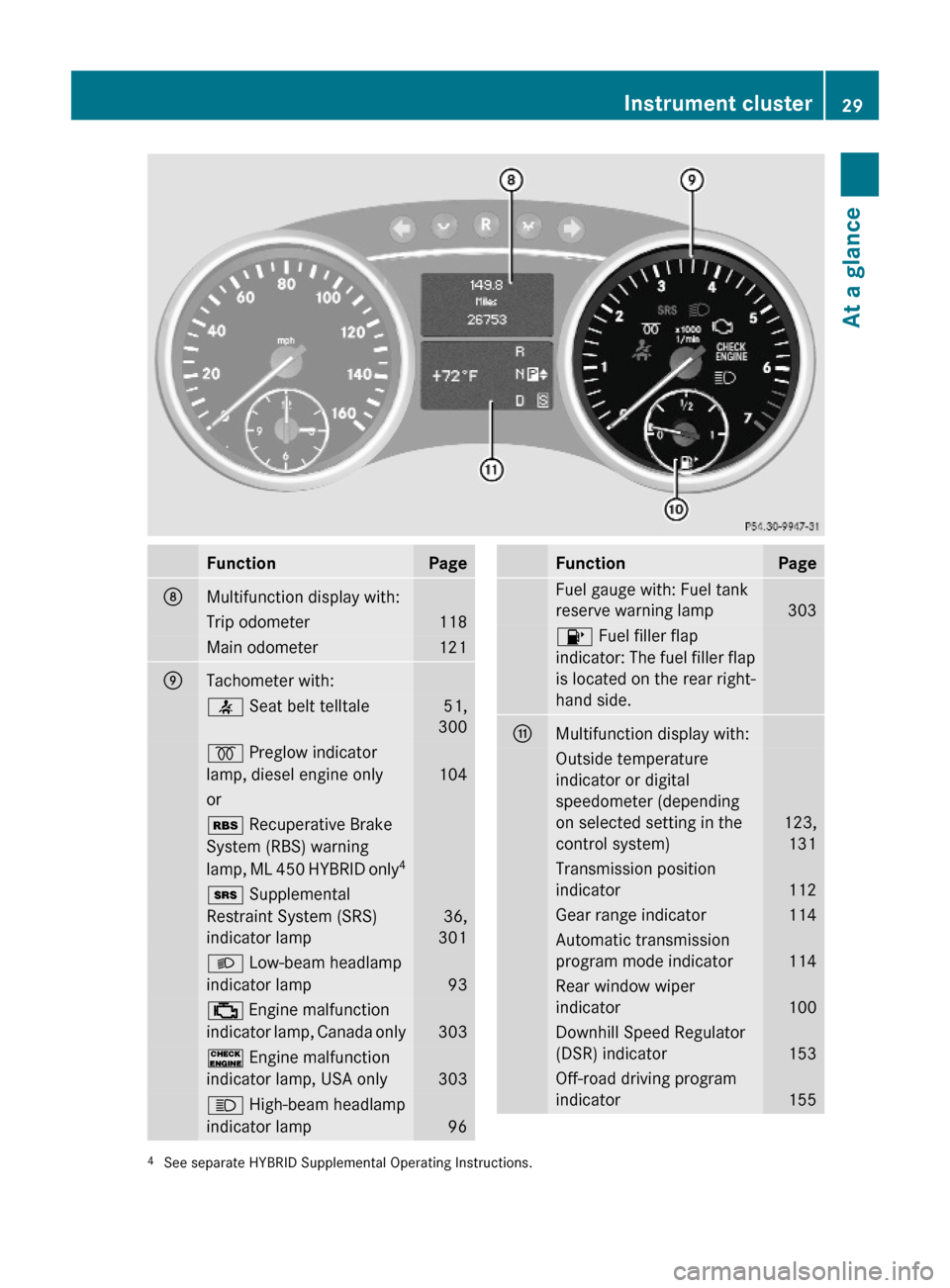
FunctionPageDMultifunction display with:Trip odometer118Main odometer121ETachometer with: 7 Seat belt telltale 51,
300
% Preglow indicator
lamp, diesel engine only 104
oré Recuperative Brake
System (RBS) warning
lamp, ML 450 HYBRID only4
+ Supplemental
Restraint System (SRS)
indicator lamp
36,
301
L Low-beam headlamp
indicator lamp 93
; Engine malfunction
indicator lamp, Canada only303
! Engine malfunction
indicator lamp, USA only 303
K High-beam headlamp
indicator lamp 96
FunctionPageFuel gauge with: Fuel tank
reserve warning lamp 303
8 Fuel filler flap
indicator: The fuel filler flap
is located on the rear right-
hand side.
GMultifunction display with:Outside temperature
indicator or digital
speedometer (depending
on selected setting in the
control system)
123,
131
Transmission position
indicator112
Gear range indicator114Automatic transmission
program mode indicator114
Rear window wiper
indicator100
Downhill Speed Regulator
(DSR) indicator153
Off-road driving program
indicator1554See separate HYBRID Supplemental Operating Instructions.Instrument cluster29At a glance164_AKB; 7; 31, en-USd2ureepe,Version: 2.11.8.12009-09-11T12:07:36+02:00 - Seite 29Z
Page 32 of 368
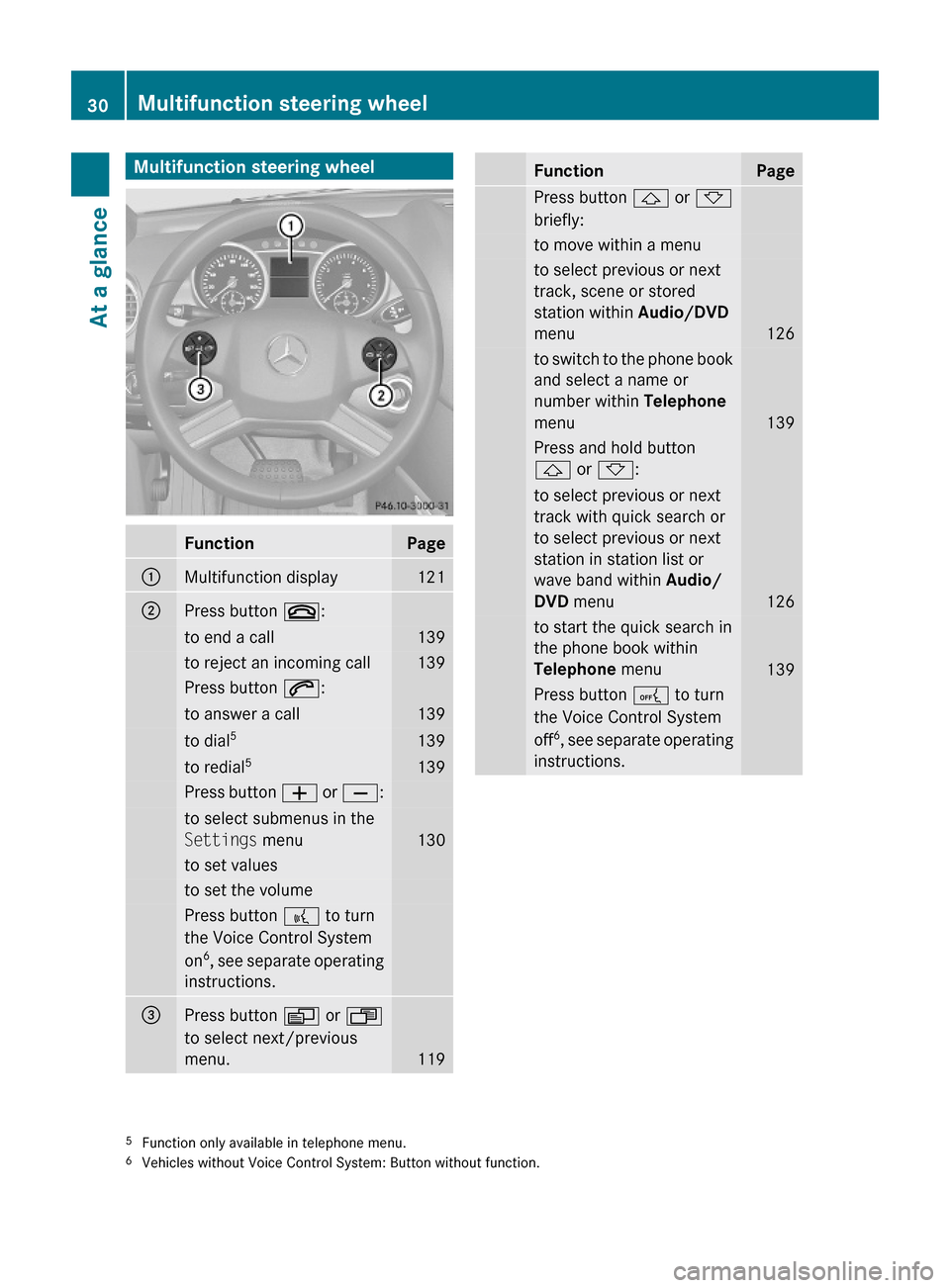
Multifunction steering wheelFunctionPage:Multifunction display121;Press button ~:to end a call139to reject an incoming call139Press button 6:to answer a call139to dial5139to redial5139Press button W or X:to select submenus in the
Settings menu130
to set valuesto set the volumePress button ? to turn
the Voice Control System
on6, see separate operating
instructions.
=Press button V or U
to select next/previous
menu.119
FunctionPagePress button & or *
briefly:
to move within a menuto select previous or next
track, scene or stored
station within Audio/DVD
menu126
to switch to the phone book
and select a name or
number within Telephone
menu139
Press and hold button
& or *:
to select previous or next
track with quick search or
to select previous or next
station in station list or
wave band within Audio/
DVD menu126
to start the quick search in
the phone book within
Telephone menu139
Press button A to turn
the Voice Control System
off6, see separate operating
instructions.
5Function only available in telephone menu.6Vehicles without Voice Control System: Button without function.
30Multifunction steering wheelAt a glance
164_AKB; 7; 31, en-USd2ureepe,Version: 2.11.8.12009-09-11T12:07:36+02:00 - Seite 30
Page 33 of 368
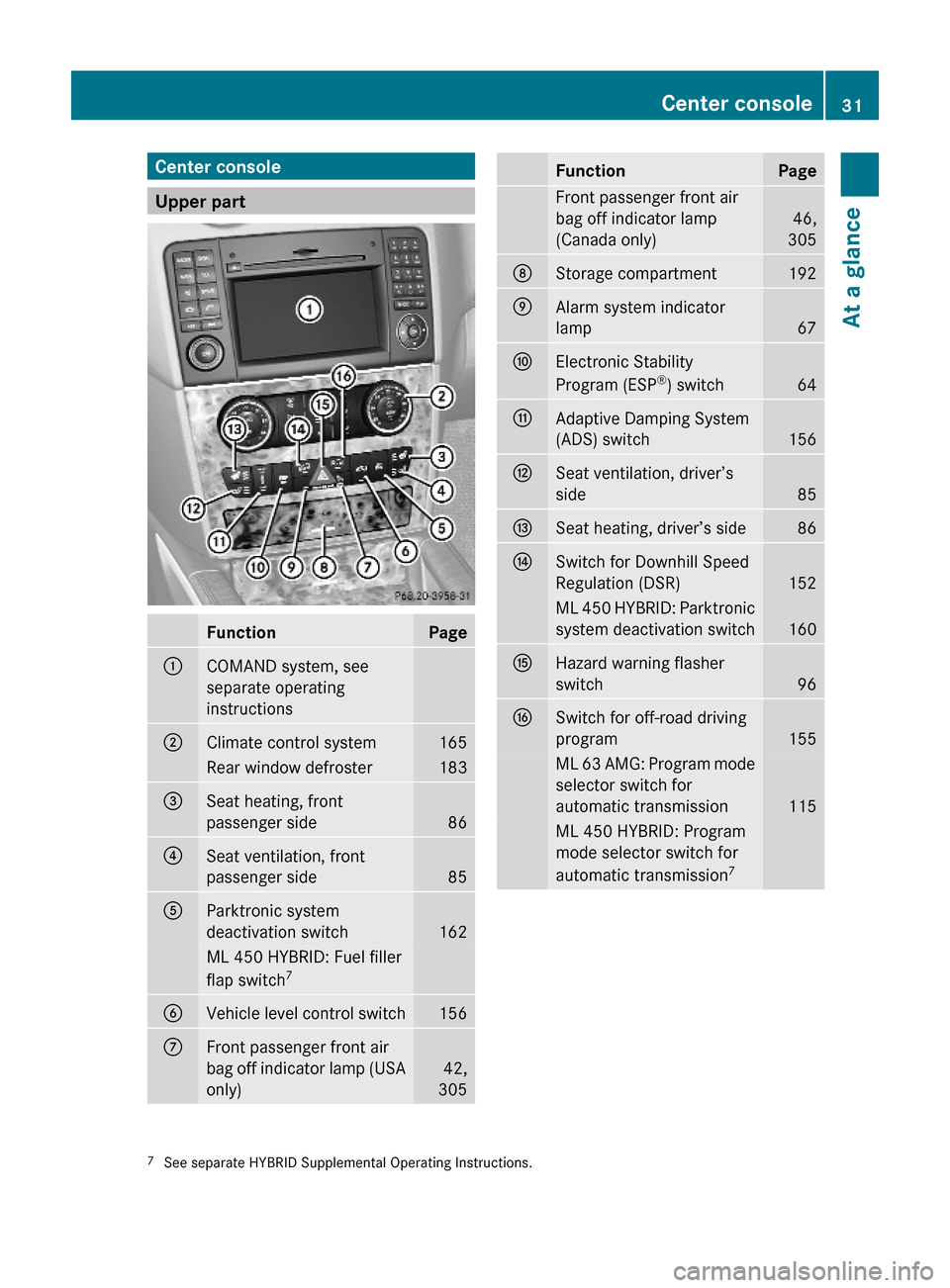
Center console
Upper part
FunctionPage:COMAND system, see
separate operating
instructions
;Climate control system165Rear window defroster183=Seat heating, front
passenger side86
?Seat ventilation, front
passenger side85
AParktronic system
deactivation switch162
ML 450 HYBRID: Fuel filler
flap switch7BVehicle level control switch156CFront passenger front air
bag off indicator lamp (USA
only)
42,
305
FunctionPageFront passenger front air
bag off indicator lamp
(Canada only)
46,
305
DStorage compartment192EAlarm system indicator
lamp67
FElectronic Stability
Program (ESP®) switch64
GAdaptive Damping System
(ADS) switch156
HSeat ventilation, driver’s
side85
ISeat heating, driver’s side86JSwitch for Downhill Speed
Regulation (DSR)152
ML 450 HYBRID: Parktronic
system deactivation switch160
KHazard warning flasher
switch96
LSwitch for off-road driving
program155
ML 63 AMG: Program mode
selector switch for
automatic transmission115
ML 450 HYBRID: Program
mode selector switch for
automatic transmission7
7See separate HYBRID Supplemental Operating Instructions.Center console31At a glance164_AKB; 7; 31, en-USd2ureepe,Version: 2.11.8.12009-09-11T12:07:36+02:00 - Seite 31Z
Page 34 of 368
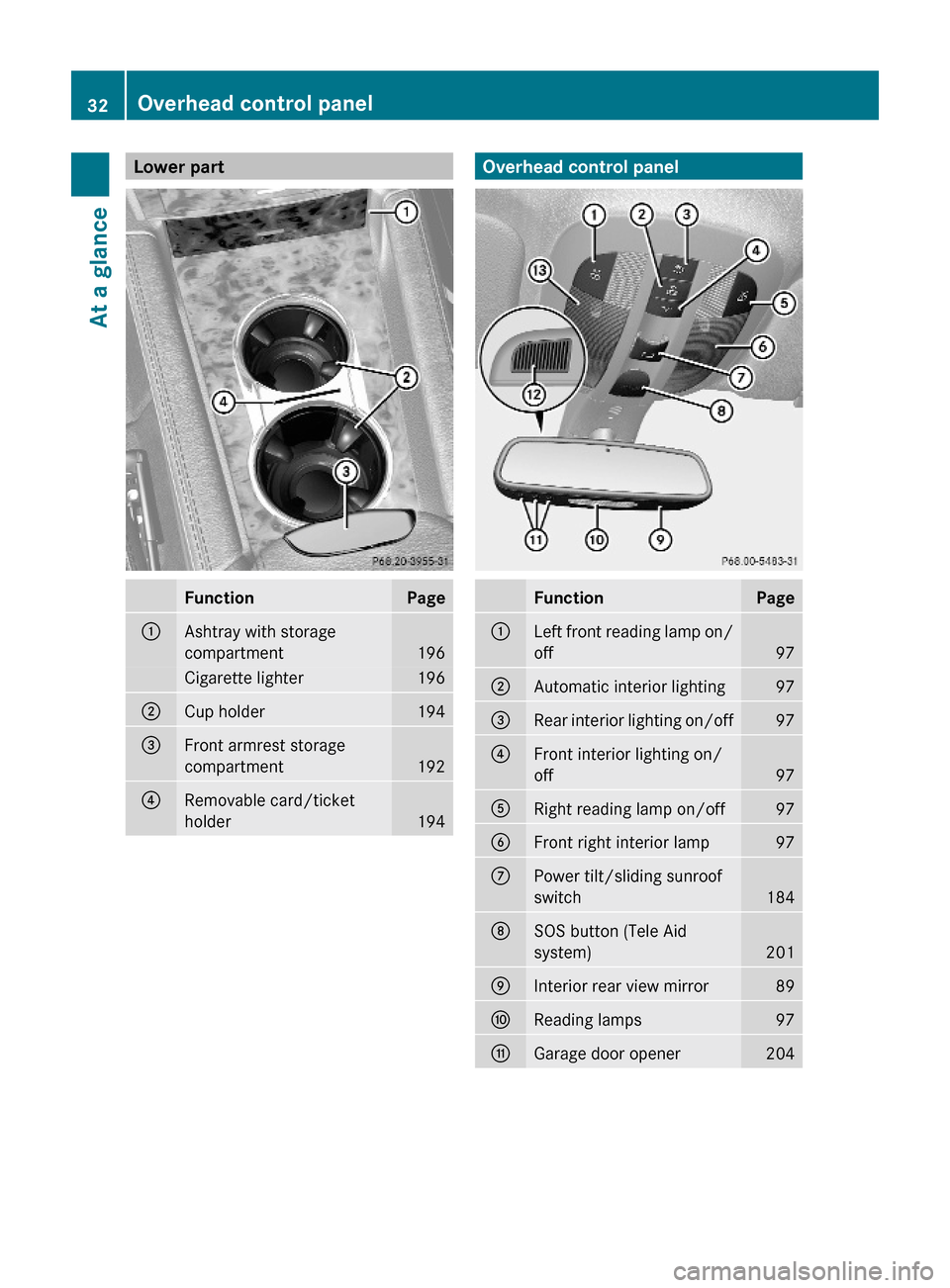
Lower part FunctionPage:Ashtray with storage
compartment196
Cigarette lighter196;Cup holder194=Front armrest storage
compartment192
?Removable card/ticket
holder194Overhead control panelFunctionPage:Left front reading lamp on/
off97
;Automatic interior lighting97=Rear interior lighting on/off97?Front interior lighting on/
off97
ARight reading lamp on/off97BFront right interior lamp97CPower tilt/sliding sunroof
switch184
DSOS button (Tele Aid
system)201
EInterior rear view mirror89FReading lamps97GGarage door opener 20432Overhead control panelAt a glance
164_AKB; 7; 31, en-USd2ureepe,Version: 2.11.8.12009-09-11T12:07:36+02:00 - Seite 32
Page 35 of 368
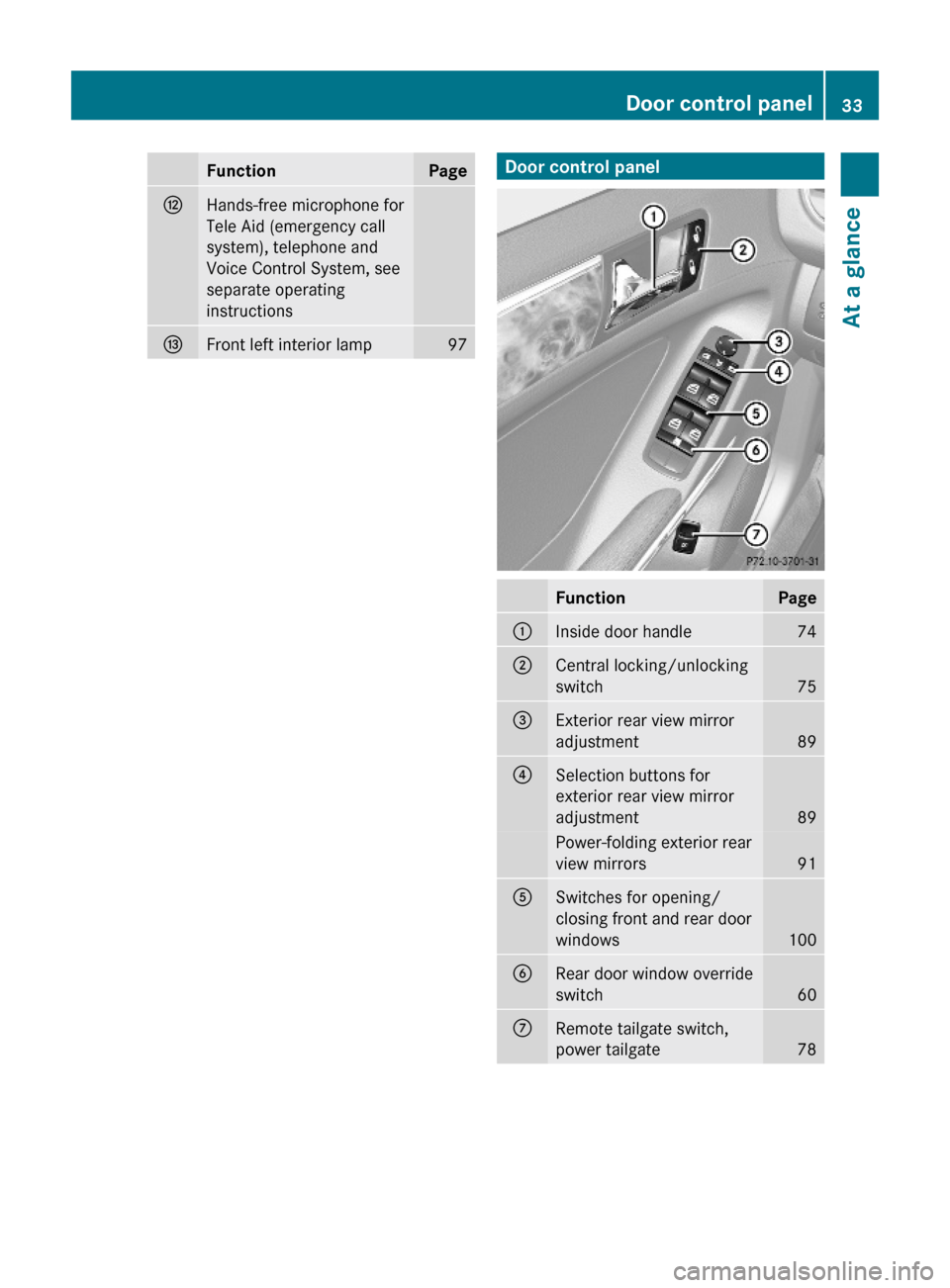
FunctionPageHHands-free microphone for
Tele Aid (emergency call
system), telephone and
Voice Control System, see
separate operating
instructions
IFront left interior lamp97Door control panelFunctionPage:Inside door handle 74;Central locking/unlocking
switch75
=Exterior rear view mirror
adjustment89
?Selection buttons for
exterior rear view mirror
adjustment89
Power-folding exterior rear
view mirrors91
ASwitches for opening/
closing front and rear door
windows100
BRear door window override
switch60
CRemote tailgate switch,
power tailgate78
Door control panel33At a glance164_AKB; 7; 31, en-USd2ureepe,Version: 2.11.8.12009-09-11T12:07:36+02:00 - Seite 33Z
Page 36 of 368

34164_AKB; 7; 31, en-USd2ureepe,Version: 2.11.8.12009-09-11T12:07:36+02:00 - Seite 34
Page 37 of 368
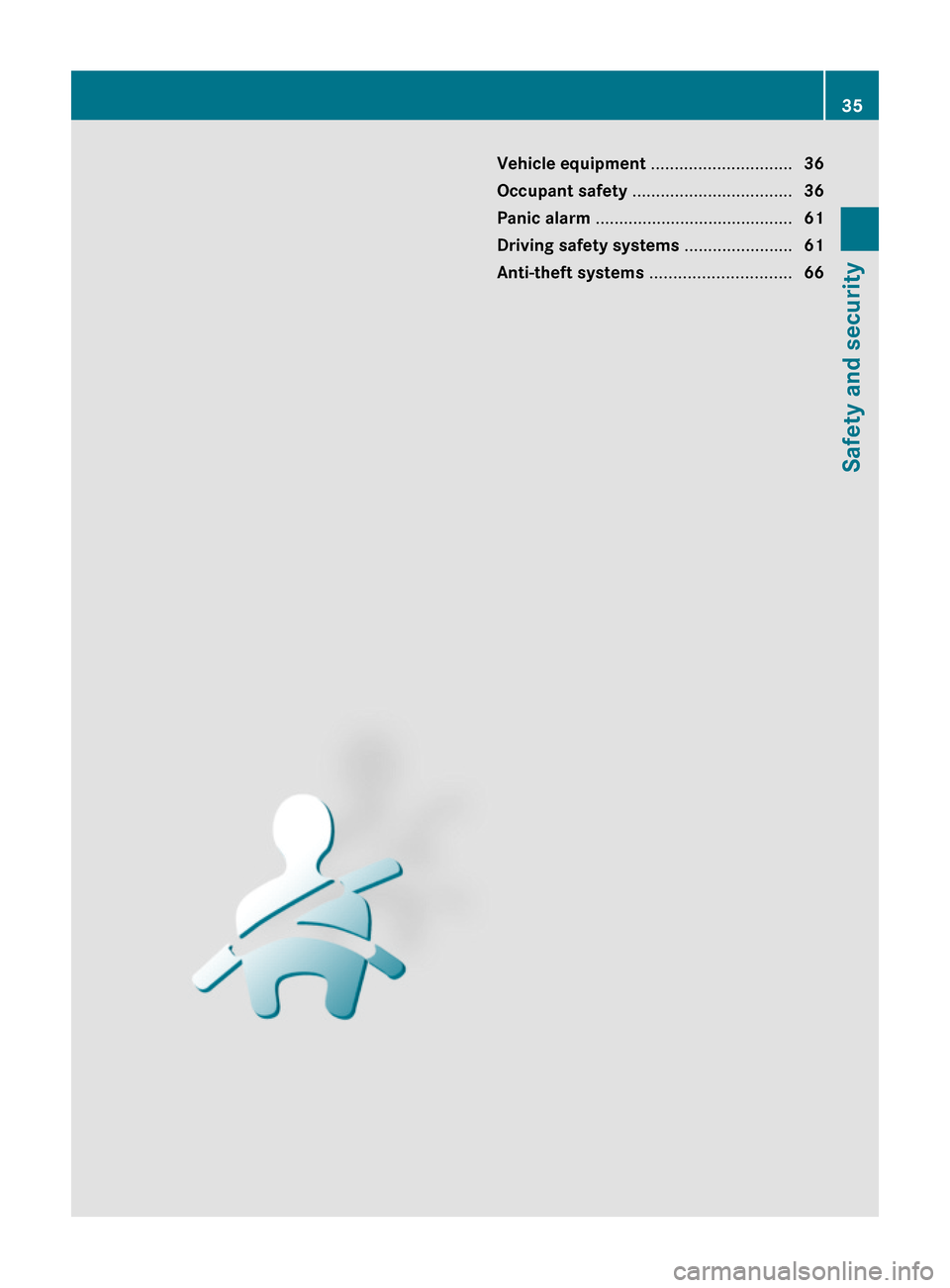
Vehicle equipment ..............................36
Occupant safety ..................................36
Panic alarm ..........................................61
Driving safety systems .......................61
Anti-theft systems ..............................66
35Safety and security164_AKB; 7; 31, en-USd2ureepe,Version: 2.11.8.12009-09-11T12:07:36+02:00 - Seite 35
Page 38 of 368
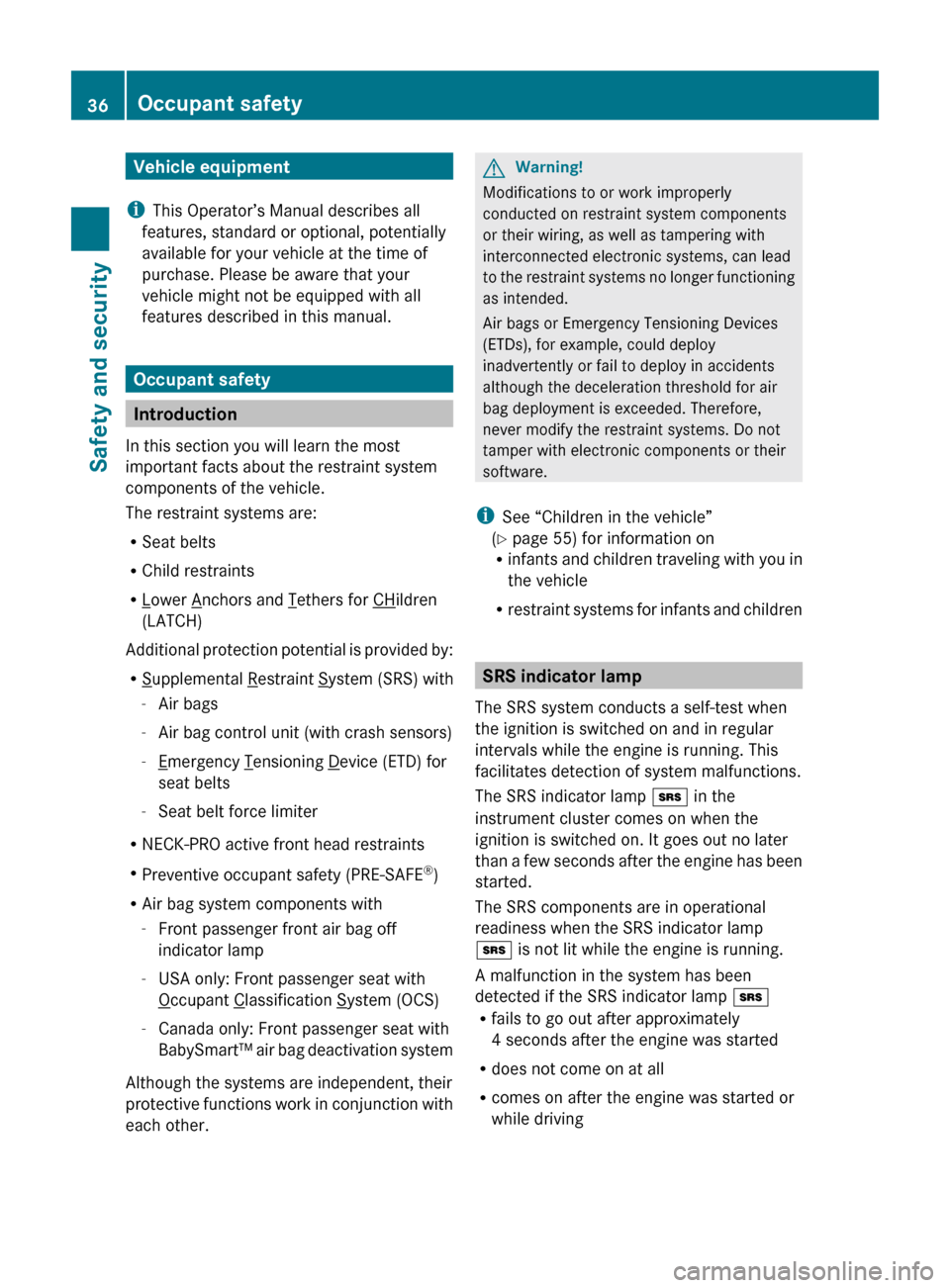
Vehicle equipment
i This Operator’s Manual describes all
features, standard or optional, potentially
available for your vehicle at the time of
purchase. Please be aware that your
vehicle might not be equipped with all
features described in this manual.
Occupant safety
Introduction
In this section you will learn the most
important facts about the restraint system
components of the vehicle.
The restraint systems are:
R Seat belts
R Child restraints
R
Lower Anchors and Tethers for CHildren
(LATCH)
Additional protection potential is provided by:
R
Supplemental Restraint System (SRS) with
- Air bags
- Air bag control unit (with crash sensors)
-
Emergency Tensioning Device (ETD) for
seat belts
- Seat belt force limiter
R NECK-PRO active front head restraints
R Preventive occupant safety (PRE-SAFE ®
)
R Air bag system components with
- Front passenger front air bag off
indicator lamp
- USA only: Front passenger seat with
Occupant Classification System (OCS)
- Canada only: Front passenger seat with
BabySmart™ air bag deactivation system
Although the systems are independent, their
protective functions work in conjunction with
each other.
GWarning!
Modifications to or work improperly
conducted on restraint system components
or their wiring, as well as tampering with
interconnected electronic systems, can lead
to the restraint systems no longer functioning
as intended.
Air bags or Emergency Tensioning Devices
(ETDs), for example, could deploy
inadvertently or fail to deploy in accidents
although the deceleration threshold for air
bag deployment is exceeded. Therefore,
never modify the restraint systems. Do not
tamper with electronic components or their
software.
i See “Children in the vehicle”
( Y page 55) for information on
R infants and children traveling with you in
the vehicle
R restraint systems for infants and children
SRS indicator lamp
The SRS system conducts a self-test when
the ignition is switched on and in regular
intervals while the engine is running. This
facilitates detection of system malfunctions.
The SRS indicator lamp + in the
instrument cluster comes on when the
ignition is switched on. It goes out no later
than a few seconds after the engine has been
started.
The SRS components are in operational
readiness when the SRS indicator lamp
+ is not lit while the engine is running.
A malfunction in the system has been
detected if the SRS indicator lamp +
R fails to go out after approximately
4 seconds after the engine was started
R does not come on at all
R comes on after the engine was started or
while driving
36Occupant safetySafety and security
164_AKB; 7; 31, en-USd2ureepe,Version: 2.11.8.12009-09-11T12:07:36+02:00 - Seite 36
Page 39 of 368
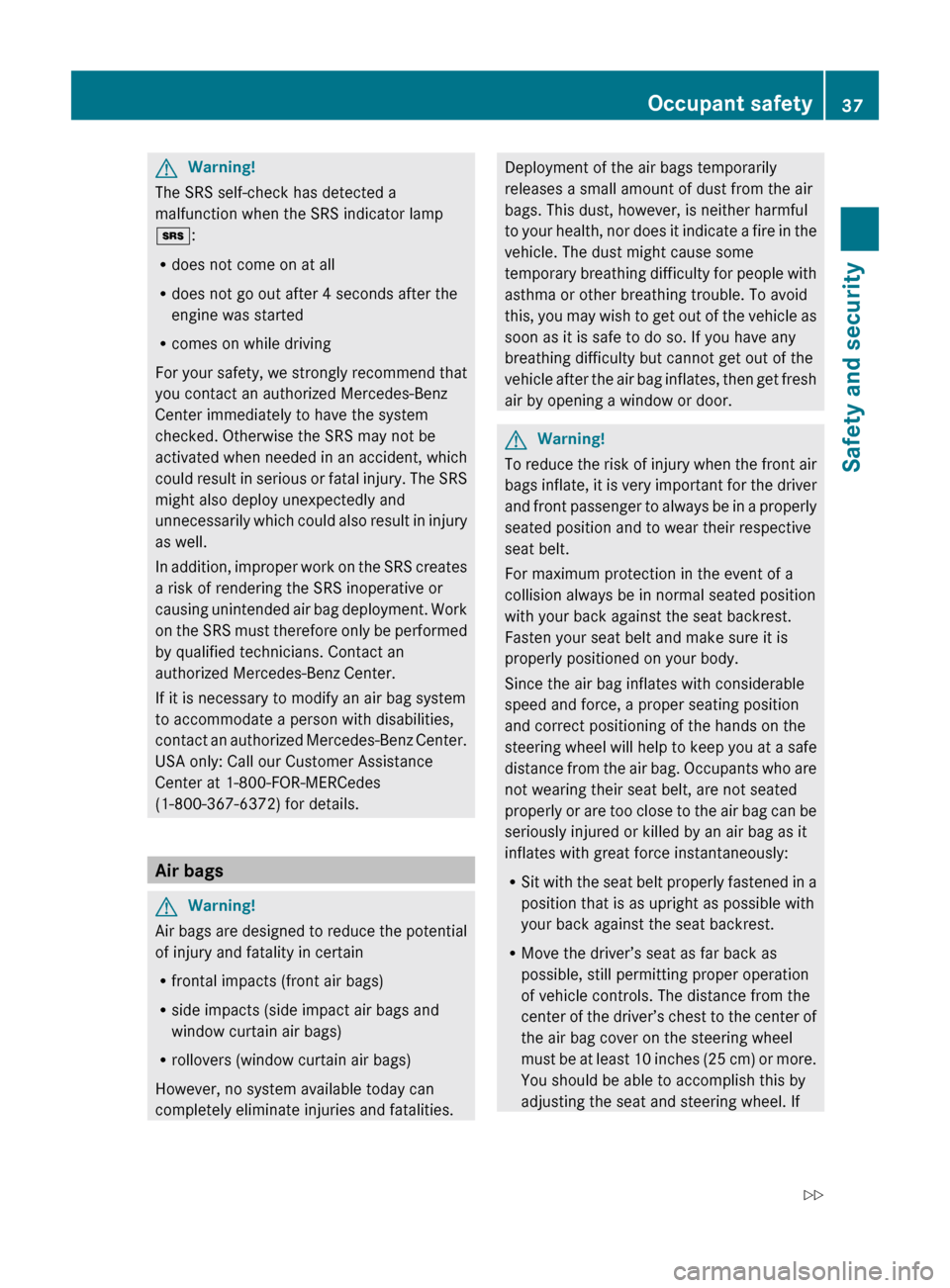
GWarning!
The SRS self-check has detected a
malfunction when the SRS indicator lamp
+ :
R does not come on at all
R does not go out after 4 seconds after the
engine was started
R comes on while driving
For your safety, we strongly recommend that
you contact an authorized Mercedes-Benz
Center immediately to have the system
checked. Otherwise the SRS may not be
activated when needed in an accident, which
could result in serious or fatal injury. The SRS
might also deploy unexpectedly and
unnecessarily which could also result in injury
as well.
In addition, improper work on the SRS creates
a risk of rendering the SRS inoperative or
causing unintended air bag deployment. Work
on the SRS must therefore only be performed
by qualified technicians. Contact an
authorized Mercedes-Benz Center.
If it is necessary to modify an air bag system
to accommodate a person with disabilities,
contact an authorized Mercedes-Benz Center.
USA only: Call our Customer Assistance
Center at 1-800-FOR-MERCedes
(1-800-367-6372) for details.
Air bags
GWarning!
Air bags are designed to reduce the potential
of injury and fatality in certain
R frontal impacts (front air bags)
R side impacts (side impact air bags and
window curtain air bags)
R rollovers (window curtain air bags)
However, no system available today can
completely eliminate injuries and fatalities.
Deployment of the air bags temporarily
releases a small amount of dust from the air
bags. This dust, however, is neither harmful
to your health, nor does it indicate a fire in the
vehicle. The dust might cause some
temporary breathing difficulty for people with
asthma or other breathing trouble. To avoid
this, you may wish to get out of the vehicle as
soon as it is safe to do so. If you have any
breathing difficulty but cannot get out of the
vehicle after the air bag inflates, then get fresh
air by opening a window or door.GWarning!
To reduce the risk of injury when the front air
bags inflate, it is very important for the driver
and front passenger to always be in a properly
seated position and to wear their respective
seat belt.
For maximum protection in the event of a
collision always be in normal seated position
with your back against the seat backrest.
Fasten your seat belt and make sure it is
properly positioned on your body.
Since the air bag inflates with considerable
speed and force, a proper seating position
and correct positioning of the hands on the
steering wheel will help to keep you at a safe
distance from the air bag. Occupants who are
not wearing their seat belt, are not seated
properly or are too close to the air bag can be
seriously injured or killed by an air bag as it
inflates with great force instantaneously:
R Sit with the seat belt properly fastened in a
position that is as upright as possible with
your back against the seat backrest.
R Move the driver’s seat as far back as
possible, still permitting proper operation
of vehicle controls. The distance from the
center of the driver’s chest to the center of
the air bag cover on the steering wheel
must be at least 10 inches (25 cm) or more.
You should be able to accomplish this by
adjusting the seat and steering wheel. If
Occupant safety37Safety and security164_AKB; 7; 31, en-USd2ureepe,Version: 2.11.8.12009-09-11T12:07:36+02:00 - Seite 37Z
Page 40 of 368
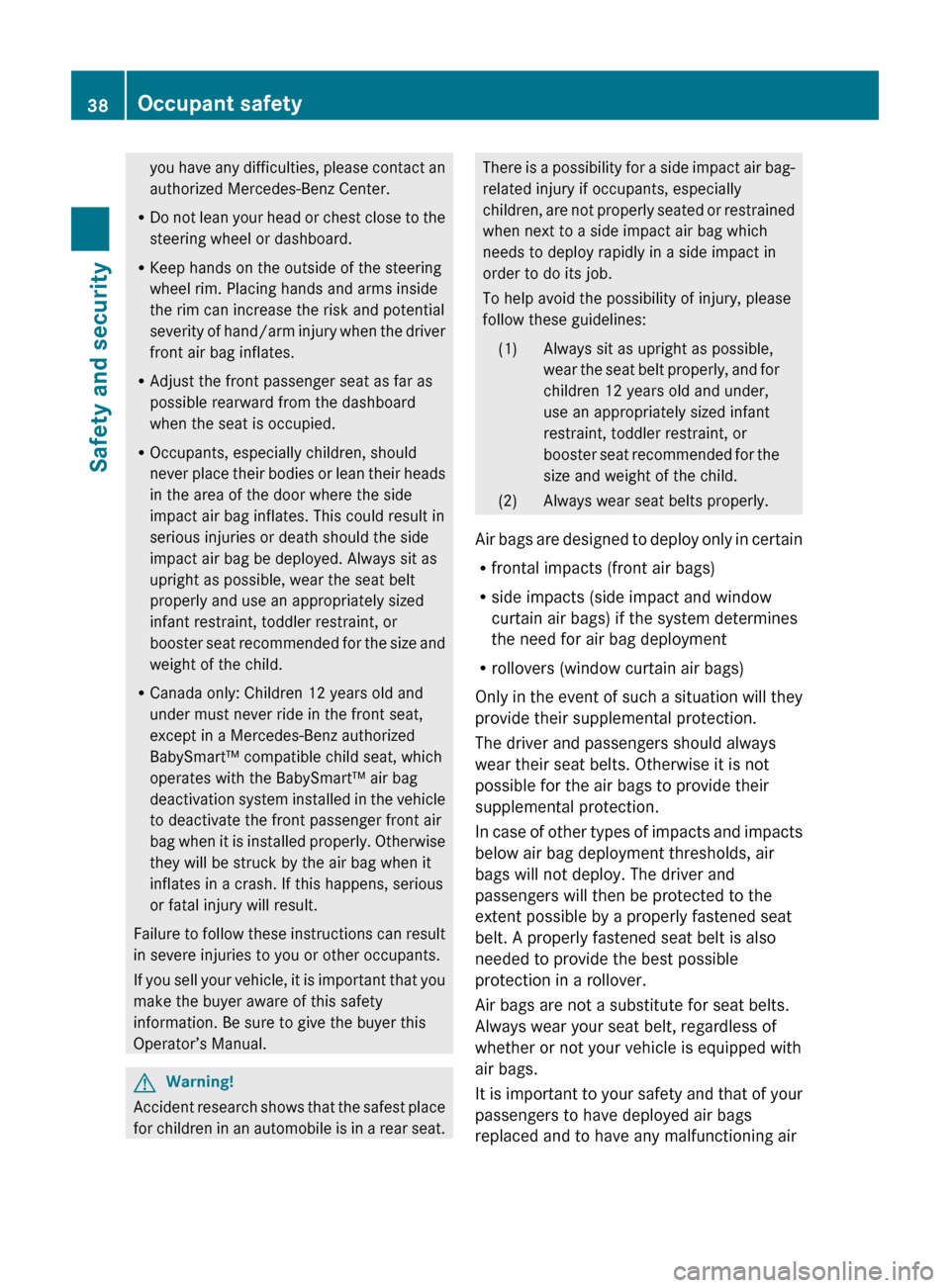
you have any difficulties, please contact an
authorized Mercedes-Benz Center.
R Do not lean your head or chest close to the
steering wheel or dashboard.
R Keep hands on the outside of the steering
wheel rim. Placing hands and arms inside
the rim can increase the risk and potential
severity of hand/arm injury when the driver
front air bag inflates.
R Adjust the front passenger seat as far as
possible rearward from the dashboard
when the seat is occupied.
R Occupants, especially children, should
never place their bodies or lean their heads
in the area of the door where the side
impact air bag inflates. This could result in
serious injuries or death should the side
impact air bag be deployed. Always sit as
upright as possible, wear the seat belt
properly and use an appropriately sized
infant restraint, toddler restraint, or
booster seat recommended for the size and
weight of the child.
R Canada only: Children 12 years old and
under must never ride in the front seat,
except in a Mercedes-Benz authorized
BabySmart™ compatible child seat, which
operates with the BabySmart™ air bag
deactivation system installed in the vehicle
to deactivate the front passenger front air
bag when it is installed properly. Otherwise
they will be struck by the air bag when it
inflates in a crash. If this happens, serious
or fatal injury will result.
Failure to follow these instructions can result
in severe injuries to you or other occupants.
If you sell your vehicle, it is important that you
make the buyer aware of this safety
information. Be sure to give the buyer this
Operator’s Manual.GWarning!
Accident research shows that the safest place
for children in an automobile is in a rear seat.
There is a possibility for a side impact air bag-
related injury if occupants, especially
children, are not properly seated or restrained
when next to a side impact air bag which
needs to deploy rapidly in a side impact in
order to do its job.
To help avoid the possibility of injury, please
follow these guidelines:(1)Always sit as upright as possible,
wear the seat belt properly, and for
children 12 years old and under,
use an appropriately sized infant
restraint, toddler restraint, or
booster seat recommended for the
size and weight of the child.(2)Always wear seat belts properly.
Air bags are designed to deploy only in certain
R frontal impacts (front air bags)
R side impacts (side impact and window
curtain air bags) if the system determines
the need for air bag deployment
R rollovers (window curtain air bags)
Only in the event of such a situation will they
provide their supplemental protection.
The driver and passengers should always
wear their seat belts. Otherwise it is not
possible for the air bags to provide their
supplemental protection.
In case of other types of impacts and impacts
below air bag deployment thresholds, air
bags will not deploy. The driver and
passengers will then be protected to the
extent possible by a properly fastened seat
belt. A properly fastened seat belt is also
needed to provide the best possible
protection in a rollover.
Air bags are not a substitute for seat belts.
Always wear your seat belt, regardless of
whether or not your vehicle is equipped with
air bags.
It is important to your safety and that of your
passengers to have deployed air bags
replaced and to have any malfunctioning air
38Occupant safetySafety and security
164_AKB; 7; 31, en-USd2ureepe,Version: 2.11.8.12009-09-11T12:07:36+02:00 - Seite 38